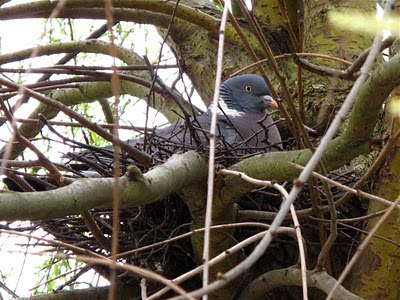Nest calling is a submissive display, mainly shown by the male and is used to attract the female to the nest or potential nest site. Caressing can occur at the same time as nest calling or away from the nest, and possibly evolved from the food begging movements of the nestling. It usually precedes courtship feeding. On the physical level the display is used to stimulate ovulation in the female, so that when used for long periods in the absence of courtship feeding it appears as a ritualized display.
And according to Cramp:
From early January, and often soon after the pair is definitely formed, the male begins to mark suitable nest sites by Nest Calling. He crouches on the proposed site (which may be a bare fork or branch, or an old nest) and makes short, sharp, downward pecking motions,
From early January, and often soon after the pair is definitely formed, the male begins to mark suitable nest sites by Nest Calling. He crouches on the proposed site (which may be a bare fork or branch, or an old nest) and makes short, sharp, downward pecking motions,
accompanied by the special nest call—a deep, double note, `coo, coo'.
The male may `nest-call' at several sites, and I imagine that the female normally makes the final choice, for the nest is by no means always built on the site where her mate has `nest-called' most persistently. The first nests are seen normally towards the end of March, and the majority start to sit in April.
More information:
Cramp, S.(1958) 'Territorial and other Behaviour of the Woodpigeon', Bird Study, 5: 55-66.here.
Murton, R.K., A. J. Isaacson (1962) The functional basis of some behaviour in the Woodpigeon Columba palumbus. Ibis: 104: 503-521. here.
More information:
Cramp, S.(1958) 'Territorial and other Behaviour of the Woodpigeon', Bird Study, 5: 55-66.here.
Murton, R.K., A. J. Isaacson (1962) The functional basis of some behaviour in the Woodpigeon Columba palumbus. Ibis: 104: 503-521. here.

Best Fake Watches UK, combining elegant style and cutting-edge technology, a variety of styles of Best Fake omega seamaster diver 300m Watches UK, the pointer walks between your exclusive taste style.
ReplyDelete